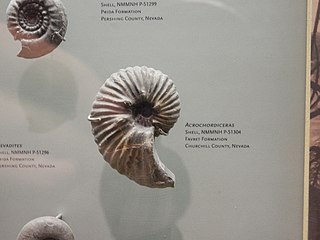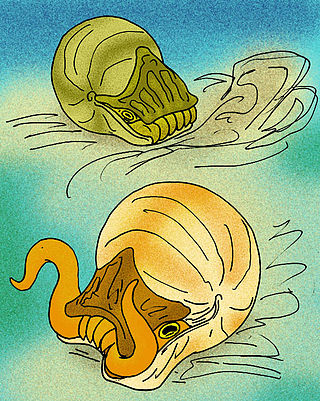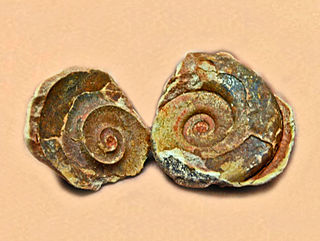Nannites is a genus in the ammonoid cephalopods in the order Ceratitida from the middle and upper Triassic of the Alps, named by Mojsisovics (1897). Nannites is the type genus of the Nannitidae which has been placed in the Danubitaceae. Previously the Nannitidae was included in the Ptychitaceae along with the Ptychitidae and, Isculitidae.

Acrochordiceras is a genus of Middle Triassic ammonoid cephalopods belonging to the ceratitid family Acrochordiceratidae, included in the superfamily Ceratitoidea.
Xiphogymnites is an extinct ammonoid cephalopod genus from the Triassic included in the family Gymnitidae. It is known from the Balkans in eastern Europe.
Alloceratites is a genus of ammonoid cephalopods from the Middle Triassic of Germany included in the family Ceratitidae.
Anatropites is a genus of ammonite in the ceratitid family Tropitidae with spines instead of nodes on the umbilical shoulder, at least in early whorls. Ceratitids are mostly Triassic ammonoid cephalopods.
Ananorites is a genus of extinct cephalopods belonging to the ceratitd family Noritidae found in the Middle Triassic of the Himalaya. The shell is thinly discoidal, evolute, and smooth; cross section highly compressed; venter narrowly rounded except at the late stage where sharp shoulders are developed.
Arthaberites is a genus of ceratitid cephalopods included in the Noritidae that lived during the Middle Triassic, found in the Alps and Balkans of Europe. Its type is A. alexandrae.
Aplococeras is an evolute discoidal ceratitid ammonite from the Middle Triassic Ladinian stage, found in southern Europe and Nevada. Whorl sides are convex, converging on a rounded venter, and are ornamented with slightly flexuous umbilical ribs that disappear outwardly, towards the venter. The suture has two lateral lobes.

Arcestes is a genus of extinct ceratitid ammonites found in Triassic-aged marine strata.
Aristoptychites is an extinct genus of cephalopod from the Anisian stage of the Middle Triassic belonging to the ammonoid subclass.
Arctohungarites is a genus of Triassic ammonoids now placed in the ceratitid family Danubitidae, but previously included in the Hungeritidae.
Badiotites is a genus of extinct ammonoid cephalopods belonging to the ceratitid family Badiotitidae. It was previously included with Lecanites in the Lecanitidae, a family formerly of the Clydonitaceae but reassigned by Tozer (1981) to the Danubitaceae. The Badiotitidae is included in the Ceratitaceae.
Beyrichites is an extinct genus in the ammonoids cephalopod, order Ceratitida from the Lower and Middle Triassic of southern Europe, Asia, and western North America.
The Noritidae, sometimes spelled Noritidea, is an extinct cephalopod family of belonging to the ammonoid order Ceratitida and superfamily Noritoidea.

The Xenodiscidae are the earliest of the Ceratitida and comprise Middle and Upper Permian genera characterized by compressed, discoidal, evolute shells with rounded to acute venters and commonly with lateral ribs. Sutures are goniatitic to weakly ceratitic.

Ammonitina comprises a diverse suborder of ammonite cephalopods that lived during the Jurassic and Cretaceous periods of the Mesozoic Era. They are excellent index fossils, and it is often possible to link the rock layer in which they are found to specific geological time periods.
Ussurites is an extinct ammonoid cephalopod genus belonging to the suborder Phylloceratina and is included in the family Ussuritidae. Its range is restricted to the early Middle Triassic, (Anisian)
Clydonitoidea, formerly Clydonitaceae, is a superfamily in the ammonoid cephalopod order Ceratitida characterized by generally costate and tuberculate shells with smooth, grooved, or keeled venters and sutures that are commonly ceratitic or ammonitic but goniatitic in a few offshoots.

The Trachyceratidae is an extinct family of ceratitid ammonoid cephalopods.
Aplococeratidae is a family of ceratitids from the Middle Triassic with very simplified sutures and a tendency to lose their ornamentation. Shells are generally evolute, more or less compressed, with rounded venters. Ornamentation if present consists of umbilical ribs that disappear outwardly, toward the venter. The suture is ceratitic or goniatitic.





